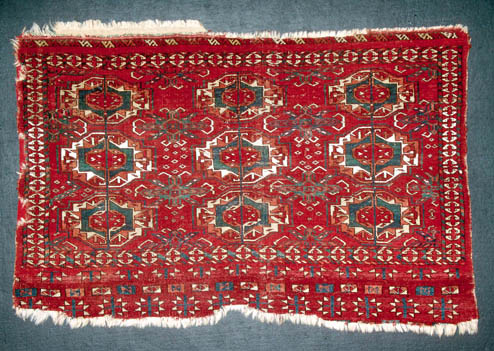
Regards, Yon
Posted by Yon Bard on 02-25-2002 10:58 AM:
Cotton?
I am wondering about whether the 'chalky whites' in no. 9 are
wool or cotton.
Regards, Yon
Yon -
It's certainly the sort of chaulky white that would make one ask. I can't remember. Perhaps Dennis will say.
Regards,
R. John Howe
Tekke Mafrash
TEKKE MAFRASH
you're right...the weaver changed materials toward the top, beginning the background with cotton and finishing
with ivory wool. This piece belongs to Dr. Marsh.
The cotton surface lies below that of the wool making it in low relief. I've often wondered if the dyers didn't
treat cotton with bleach to brighten it even more, thereby leaving it vulnerable to oxidation over time and giving
it an effect much like that which occurs with ferrous oxidation in dyed blacks and browns.
__________________
Dennis Dodds/MAQAM
This piece then is another example of the small group of Tekke
weavings in which cotton is used as 'abrash,' i.e., all the whites within a horizontal band are cotton, and those
outside it are wool. The other examples that I know of are the chuval depicted below (I think I have shown this
one on Turkotek before), and a piece that John Howe mentioned a couple of years ago hearing about from David Reuben,
I think (John, do you remember anything about it?). I am curious whether anybody else has seen such pieces.

Regards, Yon
Yon -
I remember some previous conversation about pieces with part cotton pile but just looked at David Reuben's two
catalogs and don't quickly see one in either of them. So I'm not retreiving the conversation you reference.
Dennis -
Give how relatively small this piece is
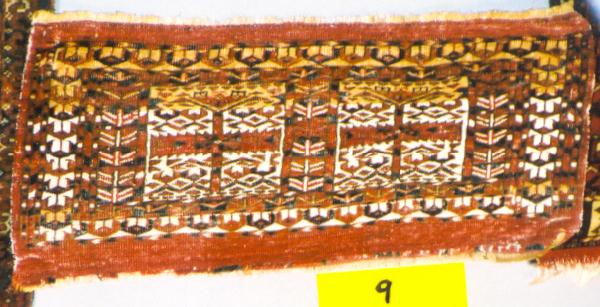
it would seem fairly easy for a Tekke weaver who is visibly skilled in other respects to estimate whether she had
enough white cotton to finish the white pile sections of this piece.
Or was cotton hard to come by in her area, did she decide to show some visible luxury by resorting to white cotton
pile, and was this all she could do?
Or is does this usage suggest that we and the weavers think entirely differently about such things?
Regards,
R. John Howe
Hi,
Plate 44 in Hofmeister's Turkoman Carpts in Franconia is a Tekke three panel mafrash. It has the more or less typical main
border, but with ivory ground wool on the top and both sides, and cotton ground on the bottom.
Steve Price
Steve, thanks for bringing up the Franconian piece. I have the
book but failed to notice this feature. Actually, according to the legend (and I think confirmed by the picture)
the whites are all wool in bottom border but cotton above that, so it is an example of the class I'm talking about.
Regards, Yon
Hi Yon,
You're right. All the white areas (borders and panels) are cotton EXCEPT the background of the lower border, which
is wool.
I must remember to make sure that the text is right side up even when I'm only looking at the pretty pictures.
![]()
Regards,
Steve Price
Yon -
This may broaden your thread more than you intend but the use of materials that were rare or expensive or luxurious
by Turkmen weavers is often perplexing.
I own a compartmented Ersair Torba with a rarish design that has 10 silk knots and cotton wefts. The odd thing
about both of these uses of seemingly expense materials by this weaver is that neither of them really "shows"
in the piece. The cotton wefts are only visible in some lower plain weave portions of the piece and I have to go
looking for the silk knots when I want to find them despite the fact that I know they're there.
Why would a weaver use expensive materials in what seem like deliberately unobtrusive ways?
Regards,
R. John Howe
John, cotton may not have been expensive in certain locations.
For example, Kurt Munkacsi in his HALI Chodor article posits that the Chodor used much cotton in their wefts while
residing in the Kiva area where cotton was abundant. The same may apply to the settled Ersari, though there isn't
much cotton used by them in general. As to a few knots of silk, the expense would not have been a factor, but it
still leaves open the question of why they'd bother. But that (along with the general topic of irregularities)
is -as we are all aware - another can of worms which perhaps we shouldn't open here.
Regards, Yon
All-cotton whites
A piece in which all the whites are cotton is a special exyreme
case of a horizontal band of cotton. Here is a Tekke example: three fragments from a small mat. Below that I show
a computer reconstruction of what the piece may have looked like (there probably were kilim bands at both ends,
but since there is no direct evidence of what they looked like I chose not to try and reconstruct them).
Regards, Yon
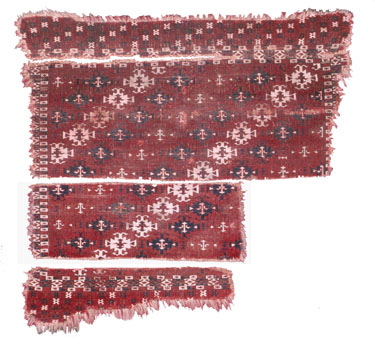
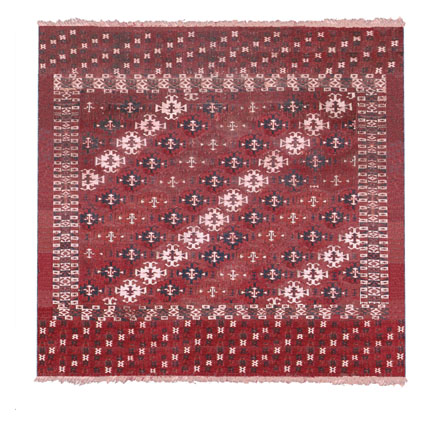
Yon, what a lovely piece of computer reconstruction.
Stephen
Stephen, thank you!
Regards, Yon
Hi People,
I believe that the subject of the use of unusual materials is going to be a Salon topic in the not-terribly distant
future, so perhaps it is best not to wander too far in that direction here.
As for use of cotton by the Tekke, many of their ak-juvals and smaller bags of that format use cotton wefts in
the bottom panel.
Regards,
Steve Price
Here's one more to add to the mix. this Tekke torba has cotton
whites in only half the rosettes at gul-center in only the top row of guls; curious!
I apologize for the photo, but I think you can see the brighter white in the center of the top row of guls:
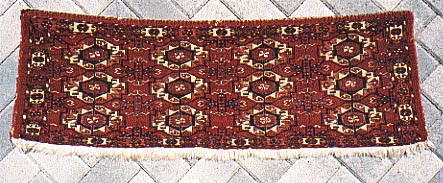
Regards,
Marvin
I forgot to add that the other half of the rosette is silk.
marvin
Steve, this is becoming frustrating: Can't talk about the rug
because it's for sale; can't talk about the ensi because there'll be a Salon about ensis; can't talk about silk
and cotton because there'll be a salon about unusual materials!
Regards, Yon
Hi Yon,
Our policy of not discussing rugs that are for sale is a longstanding one. We recognize that it sometimes hinders
pursuit of worthwhile topics. We think the tradeoff - that it keeps us from becoming a venue for commercial promotions
which, in turn, allows us to maintain the credibility and integrity that we value - is worthwhile.
I didn't mean to stop you from talking about materials. Cotton and silk are not all that unusual relative to the
materials that I believe will be discussed in that Salon (assuming, of course, that it materializes). My wording
was poor - my intent was to discourage going much beyond silk and cotton when I suggested that we "not go
too far in that direction."
John, I believe, noted that he was planning a Salon on ensis that would lean on the exhibition of ensis at the
next ICOC, and asked for a hold on that subject. My own opinion, for whatever weight it lends here, is that we
can't ignore subjects that come up - especially subjects that are within the introductory essay itself (which includes
one ensi and another rug for which an ensi function was suggested) - in deference to a similar topic coming up
at some point in the future. John's next Salon probably won't be on the boards until four to six months from now,
perhaps even later.
So, carry on with whatever your spirit moves you to discuss.
Regards,
Steve Price
Four to six months 'til I have to host again.
Introduce me to this notion slowly. I'm likely to get a species of the "bends" from the release of pressure.
I hope THE MAN doth not count too optimistically.
Talk away about ensis (although we will then insist on "engsis") all you want.
Regards,
R. John Howe
Hi John,
Since we are on a one-Salon-a-month schedule, in the complete absence of a guest hosts we each come up every three
months. My statement that you PROBABLY won't come up again for four to six months seems reasonable or, at least,
not wildly optimistic. If no guest hosts materialize, it will be three months. Each Salon hosted by a guest pushes
that back by one month. I can't read the future, but past experience suggests that one to three guest hosts are
likely to show up in the next three months.
Be of good heart.
Steve Price
Cotton/silk?
Dear Mr. Dodds,
In some rugs, the kitsch comes from the mercirized? cotton. If a rug gets old, the silky glow disapears because
of cleaning, wear and tear.
So, if one sees cotton and silk in one rug, and the rug has some age, I think some alarm bells should be ringing.
At the time the rug was made it was fraud, now it's a Rara Avis.
So this oxidating of the cotton pile, could be a lead.
I've seen this in "Tourist" Iranian products from the sixties as well.
I have one!
Best regards,
Vincent
Hi Vincent,
That's an interesting thought. Do you (or does anyone else) know of a way to tell if old cotton had been mercerized
once upon a time?
The fact that cotton pile is often much lower in height than wool on the same piece is generally interpreted as
corrosion of the cotton. I'm not convinced that this is correct. Cotton has very poor resilience compared to wool,
and tends to mat down and not spring back to its original height. This would account for cotton pile being lower
than wool.
Regards,
Steve Price
Dear folks -
I can think of a couple of possible ways to test in the cunnumdrum that Vincent proposes of an "old"
rug that has both "cotton" and "silk" in it.
First, a burn test would indicate whether the silk is silk and whether the seeming cotton is that.
Then, it may be possible to estimate that the cotton is both cotton and not mercerized by examining the cotton
to see if it has been hand-spun. Murray Eiland estimates that (at least for Chinese rugs) nearly all cotton was
handspun before 1850. Handspun cotton seems recognized by irregularities in it and by a relatively few (say five
or less) number of plies of fiber of which it is composed (although some instances of handspun cotton with larger
numbers of plies are known).
Third, because the web is such a wonderful resource I did a quick search to find out when mercerized cotton might
first have been available. Here is a nice link:
http://anwg.org/resources/articles/mercerized.html
It seems that the mercerized cotton process was invented in 1850 and was in use by 1890. It also seems that we
might be able to test for the presence of the chemicals (primarily caustic soda) used in the mercerizing.
Just some thoughts about Vincent's question.
Regards,
R. John Howe
Thanks John,
So we have to lick the cotton piles and put our noses in. Way to go.
Greasy Naïn look-a-likes. Knotted in Naïn!
The cotton sticks out after a while because it unwindes? more easy. Because of this it breaks off more easy. Because
of this it shows more signs of wear after a while.
Some Kashmir products. Merce!rized cotton.
I have a beautiful Turkmen, made in Iran, absurdly fine knotted that has been bought with silk warps in the 50'ties...but
as time passes....the silk gets older..and when things get older...well time is very honest.....the silk gets a
cotton look.
The woolen pile gets more silky!
Think, it's the combination that should ring a bell. If it looks to good to be true, it mostly isn't.
Why knotting with white cotton? Why not knotting with colored cotton (Should give the same highlight effect)
A terrific wool in a terrific Turkmen doesn't need white cotton. A terrific white wool has the same (I think more
beautiful in time) effect.
Best regards,
Vincent
Vincent, I don't understand what you are saying. Why is a combination
of silk and cotton highlights a fraud? Look at the Saryk chuval below. Is it a fraud? Why shouldn't weavers use
cotton highlights to achieve real sparkling whites?
Regards, Yon
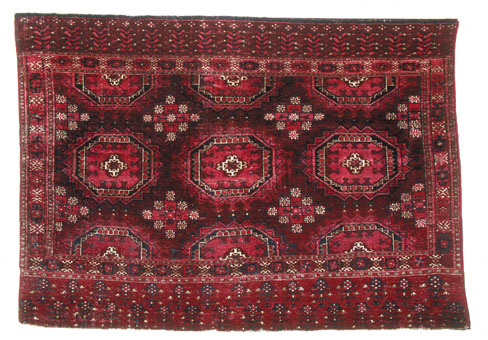
I think Yon is correct. The torba that I posted above with a
little bit of cotton and silk also has a lac dye which is corrosive to the wool resulting in a wonderful embossed
effect. The use of lac dye is old - before the 20th c. It is stated that pieces such as Yon's above with no cotton
and little silk are older, but I've neve seen any credible evidence for this.
Regards,
Marvin
Hi Yon and Marvin,
A raw, pure, undeyed cotton gets greasy, greyish in time if used in a nomadic setting. It won't show the highlight
effect in time. Cotton is very strong and because of this it picks up dirt etc. very easy and it won't let go of
it in time. That's why wool is prefered.
So when still sparkling white:
1. It has to be bleached.
2. It has to be dyed sparkling white
3. It has been mercerized/castric sauda (and because of this will pick up dyes more easy, (thanks again John for
the link you provided), so why never a highlighting colored cotton pile?)
4. A pure/raw cotton in pile will not show the highlight. In woven items it's a different subject.
Just a few thaughts of a suspicious mind.
Fraud? Inventive weavers is better.
Invinttivecent![]()
Hi Vincent,
I have a Beluchi saddle rug with the Salor Khani motifs outlined in cotton - grey and yellowed - as you predicted,
but.... also "corroded" from what? Definitely not bleaching. This saddle is very old (whatever that means)
with a bit of silk, obvious wear where the saddle edges were and a handle like a fine handkerchief. I respect your
skepticism, we need more of that in this world with no data and lots of speculation
Regards,
Marvin
Hi Marvin,
Are you sure the cotton is corroded, and not just matted? Cotton is much less resilient than wool, and doesn't
"spring back" to its original height the way wool does.
Regards,
Steve Price
If it's not corroded, it was sheared; not matted at all. I believe
it has worn: lot of sun and a tough butt rubbing it. I don't know about the resilience; the density of the pile
where there is cotton seems more than where there is wool. I can imagine the wool fibers separating as someone
mashes on it, but the cotton would be abraded. The piece is in Vanishing Jewels if you want a visual of what I
speak.
Regards,
Marvin
Vincent, who says anything about 'raw unbleached cotto?' All
I know is that there are plenty of indisputably 19C pieces with brilliantly white cotton. There are very few pieces
with brilliantly white wool. Why, I don't know.
Regards, Yon
Rotten Cotton
Butt Rubbing?
I showed an "Ersari Beshir" torba a couple of months ago on the Show & Tell. I had never paid any
attention to the material, assuming it was all wool, until Elena Tsareva examined it and noticed that some of the
whites were cotton. Upon washing, the dirty/gray cotton brightened up considerably. Why use cotton? It makes a
visual impact. These things were made to be noticed. A little brighter white adds some visual stimulation to these
pieces.
The cotton was no lower than the rest of the pile because all of the pile is of an even height (low).
As for the burn test, usually there is little enough silk in these weavings to remove enough to tell, and few of
us would be willing to remove enough to do a test because it would affect the appearance of the weaving. John,
are you willing to remove one of the three knots in your bagface to do a burn test?
I have related the story of a dealer inspecting a silk-warp antique Turkish rug and suddenly tearing a length of
warp off, explaining to the shocked owner that old silk is brittle and this proved it was silk. He did not buy
the rug anyway.
Patrick Weiler
Hi Pat, Vincent et al -
I only mentioned the "burn" test, which we all know of, in order to get rid of the question of whether
there was actually silk in the piece Vincent is suspicious of. When silk is used in minute quantities, it is true
that this test is impractical. Besides most of us wouldn't care whether 10 knots are real silk or not.
I also share Marvin's though that it's good to be suspicious but I think on older Turkmen pieces Vincent is a shade
paranoid. As both Yon and Marvin have pointed out there are lots of pretty old Saryk pieces with lots of white
cotton in them and I'm having trouble feeling suspicious about that. Most of these pieces were likely woven before
mercerized cotton (did my link not estimate that it was invented in 1850 but not picked up much until perhaps 1890?)
was available and in some instances before it was invented. Why is the cotton still whiter than the wool? My guess
is it always was and that such pieces were not used much but mostly stored away.
So while I think it's good to be skeptical in our world, I think that it is likely misplaced when one encounters
either cotton or cotton and silk both in an older Turkmen piece. Such suspicion lacks, among other things, motivation.
Now if the examples given include pieces woven in, say, 1950, then anything is possible. I know of one such Turkmen
design piece woven on silk warps that the dealer who owns it is sure will someday be in a museum (fine precise
work). But it was obviously woven by a non-turkmen because the Tekke-style main carpet guls have been rotated 90
degrees. This would puzzle us on an 1850 piece seemingly woven by Turkmen but not on a newer piece woven by who
knows. On such later pieces the practices that Vincent has highlighted here might well exist.
Regards,
R. John Howe
Dear Patrick,
The guy didn't buy the rug doesn't surprice me. Old silk isn't brittle, it detonates the moment you look at it,
so no need to pull a fringe. (But maybe the guy was blind). Old cotton, especially the fringe gets brittle in time.
Some cotton fringe in 20 years. Did you ever see a Heriz from the 50'ties that didn't get the wholesale treatment
(no borders at the ends)? A Heriz with fringe is even more rare etc. etc. I think a mercerized (castric soda) cotton
is very brittle in time.
Dear Turkotekkers,
Please, I'm not saying all beautiful old Turkmen trappings etc. are out of order if cotton is aplied.
If the cotton is treated in a delicate, design way, it can be o.k. As silk is o.k. if done delicate.
But, it gives me a Kitsch feeling. So if not only paranoid, it's a lack of taste I'm suffering of.
If the cotton gives an obvious abrach, a sort of breaking the rhythm in design I have to ask myself the question...Why?
If silk and cotton are used together without any design rhythm? Why?
No Turkmen with white wool......isn't that strange? Maybe because they didn't like it...the white.
Or did they like white that much, they needed more brighter white?
And why didn't the brides make the trappings in white cotton and did they use white wool?
I once had one, sold it to the the South of France, still having nightmares. Why did I sell it?
Poor, foolish dealer. Think it was the language that did it. French melody.
It had the most beautiful white wool background. The red gulls bursted out in genuine passion. This girl wanted
to get married right away.
And in the end, it's terrible, it's frustrating, it's..........I don't know!
But being suspicious at some times doesn't hurt I think.
Paranoid....na......if John thinks I'm paranoid.....na...think that's o.k. too.
If a Paranoid was telling me I'm paranoid.....it would be a different subject.
No, I'm no paranoid.
John? You're ok? Aren't you?
Vincofrenic
Am I? Vincent? Who's there?
What are you all talking about?
When is this going to end!
I can hear you!![]()
Hi Vincent -
Cheer up! Even paranoids have friends. You're surrounded!
Oops. Wrong word.
Regards,
R. John Howe
Vincent, here is a Turkoman with clear white wool highlights.
I don't know of any others. Does anybody else know of some?
Regards, Yon
P.S. I have discussed this rug previously on Show and Tell in an attempt to get an attribution. Nothing definite
came up; Tsareva saw it and said 'Yomud Group' which isn't terribly helpful.
P.P.S. the field color is much browner than appears in this picture.
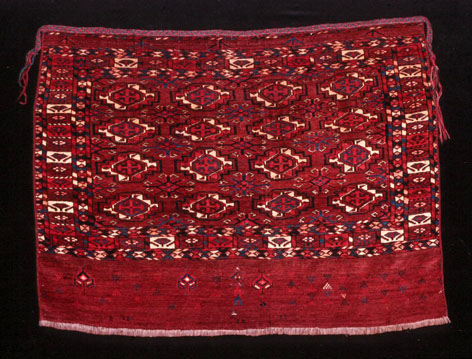
Gorgeous!
Dear Jon:
Could you tell us the structure of this piece? It's really beautiful.
Thanks,
Sophia
Also - I would guess the small amounts of silk or cotton, randomly applied, could have been placed their strictly
for emotional reasons, private reasons.
Maybe even a sort of signature.
Whole bands - that I don't understand, unless it's for the obvious reason - to add some pizazz.
Now - before I burn the house down - or the rugs up - could somebody please remind us what the burn characteristics
of silk, cotton AND RAYON are, please?
Thank you!
Fire
Hi Sophia,
Cotton and mercerized cotton produce a flame and leave a powdery ash smelling like burnt paper.
Silk does not burn with a flame, but simply glows and is reduced to ash.
Artificial silk reacts in a similar way but gives off an acrid smell.
Keep the Fire Department number handy.
Regards,
Filiberto
Sophia, the piece is asymmetric open to the right, 18/inch vertical,
8/inch horizontal.
For completeness, wool burns with stron odor of burning hair.
Regards, Yon
Highlights in Cotton
Greetings, CottonThreaders,
First: Yon, here's a Saryk of mine that has a significant amount of cotton in it, clean bright and white. Which
makes me suspect that bags with this much cotton were probably hung inside the oy rather than slung over the side
of a camel and exposed to the elements. The photo loses the violet-red secondary color in the border.
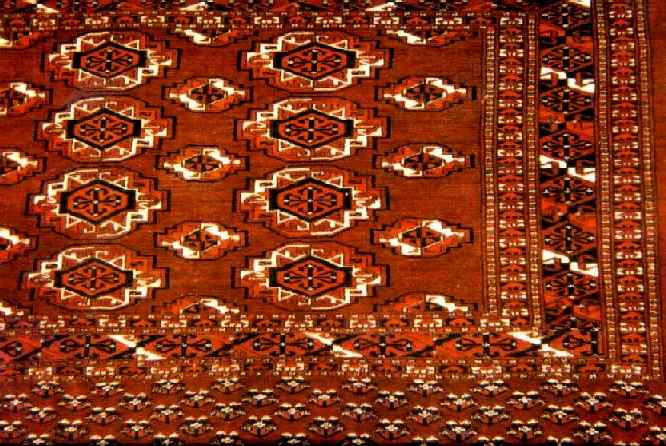
Here's the whole thing, but the between image reduction and sharpening, I seem to have removed everyones ability
to niggle about the details...
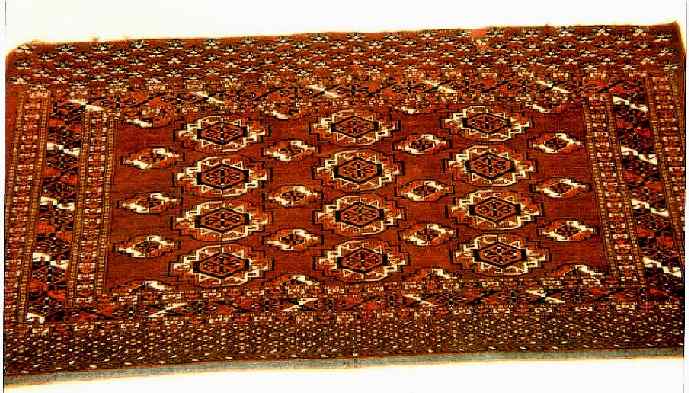
And, here's a few bags that I have(not particularly old, I should note) that use cotton as highlights in an otherwise
all wool structure. First, a Yomut ?? kilim bolesht from NW Afghanistan or NE Iran:
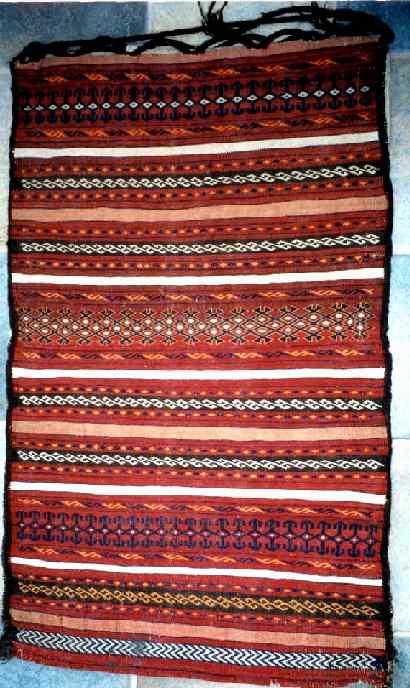
Next, what is probably an Ersari Turkoman khorjin from far NE Afghanistan. In the detail photo, note that only
some of the highlights are white, the others are a transparent yellow:
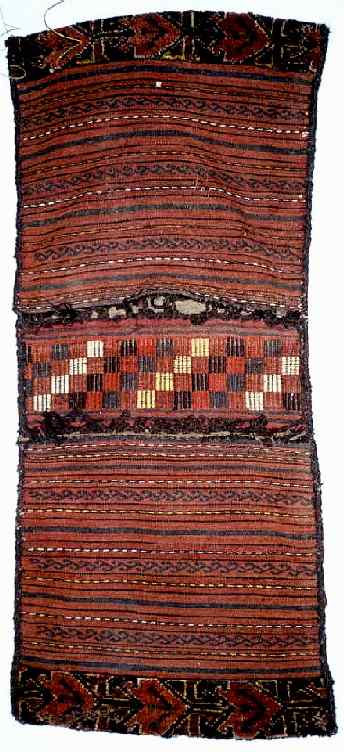
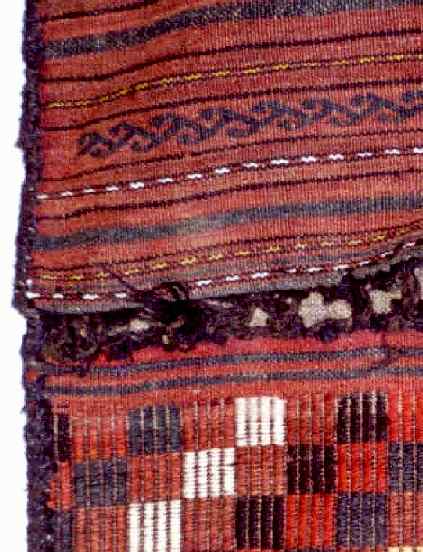
And last, an Afghani Hazara (or other Uzbek tribe) saddlebag with substantial amounts of cotton. Which makes sense
because there is a lot of cotton grown in the Amu Darya valley in north central Afghanistan. It has the look that
Vincent was describing (and a close up; toss a bone to Marla):
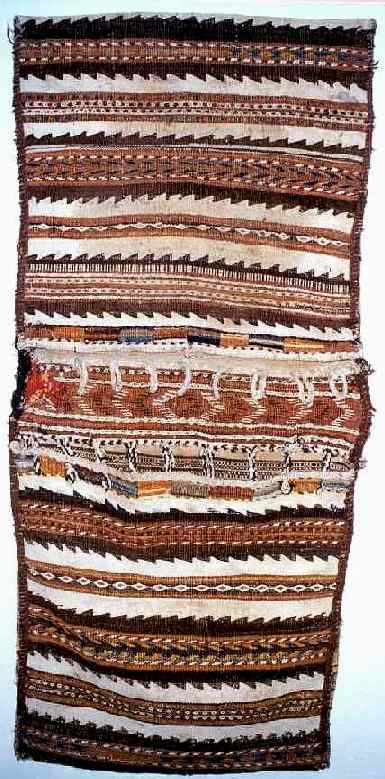
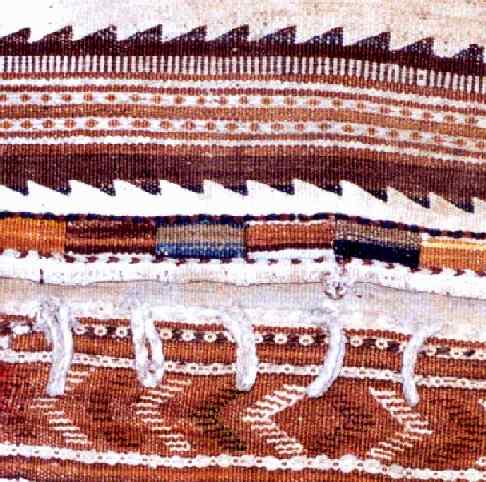
Regards,
Chuck
__________________
Chuck Wagner
Chuck, it is more than 'suspision:' chuvals were certainly made
to be hung in the tent, not to decorate animals. However, your khorjins show that bright cotton whites could survive
even on horse or donkey back.
Regards, Yon
Hi,
This Tekke mafrash came to us in 1967.
45x120/10cm, a-symm. knots. Open right.
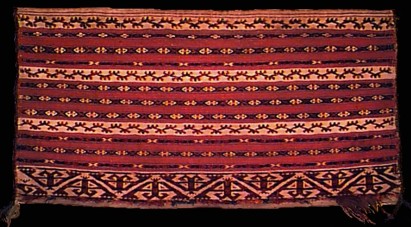
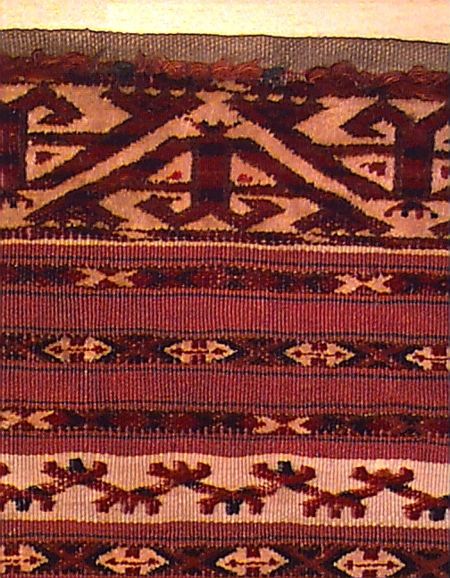
It's upside down here. Sorry for that. No cotton. All wool. 30 silk, pink knots. Think this fits in nice, in between
all the loved ones shown here.
Cotton, silk or whatever, I like what I see. The more images, the better.
What's up next?
Best regards,
Vincent
ps. First image is upside down. So the weaver started with the front.
Size is 40x25cm ±
Gorgeous Chuvals
Dear Jon, et.al.:
Thank you for the burn reminders - I will try not to cause another Chicago catastrophe.
AAACCKKKKKKKK.
I think "Yomut group" might be as close as you will get to attributing your bag, Jon - the structure,
border design, proportions and the little bird's feet at the top all fall right in line with at least one sub-group
but I don't think anybody's successfully broken out a tribe or tribes, to make reliable attributions. This would
be a great project, though.
Chuck's bag is gorgeous too - but as far as the elements are concerned - I'll bet the smoke in a yurt is as bad
a pollution factor as any. Most of the whites on my Turkmen show "smoking" to some degree, some very
severely. Perhaps the chuval was kept away for special occasions? I have a Saryk ensi with cotton "whites"
that look ivory or even gray in places, as others have described.
I wonder if the smoke affects other colors as well, perhaps chemically?
Hi Sophia,
My guess is that smoke affects all colors, but not enough to be noticed except on white. It doesn't take much tint
to make white obviously not white, but fairly small changes in hue or intensity are not easily discernable on most
colors.
Smoke causes terrible artifacts in C-14 analysis, and can add centuries - even millennia - to the outcome. So,
rejoice
(which, I suppose, means joice and then joice again)! Your smokey stuff could test out as the oldest known Turkmen
weavings. Unless, of course, someone has Turkmen stuff that's even more smoke-tainted than yours.
Regards,
Steve Price
Oh Joy
Dear Steve:
I have a feeling I might have the world's oldest Ponceau2![]()
Dear Yon,
Like the all wool Turkmen you posted best. Maybe it's because it doesn't shout at me.
(Altough there seems to be someone waiting for the taxi to come. Is it male or female?
I have one that shows a male.)
Same goes for the tiny mafrash I posted. I take my hat off for who ever made it.
Eat your hart out Gucci, or whatever:This is something you will never make.![]()
The mafrash was from Persia. It was sold for 90 Dutch Guilders is 30 US dollars in those days.
Cleaned it with my..................toothbrush![]() ........non electric.
........non electric.
Chuck,
Think all items are recent production.
If I'm wrong it's because the internet doesn't smell.
Maybe, Yon, that's why all the cotton is whiter then white?
Best regards,
Vincent
Vincent, here's one you're really going to hate: a Saryk main
carpet fragment with profusion of white cotton. The complete rug must have been quite a startling sight! The odd
thing about it is that the cotton area are actually slightly thicker than the wool!
Regards, Yon
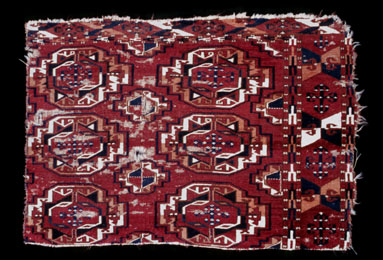
Bags
Vincent et all,
Yes, the bags are "newer" production probably no more than 30-40 years old, with the exception of the
NE Afghani khorjin which I suspect is early 20th century. There's a lot of wear on the pile at the bottom edges,
it's very supple despite a very tight weave, and in REAL close up view the dyes have the look of vegetal dyes.
No fading, no running, variegated, clear, etc. Either that or small batches of well done synthetics. But new doesn't
bother me so long as the work is high quality and the dyes don't run; the synthetic dye makers didn't conduct pogroms
to purge the global gene pool of good weaving skills.
I included the new bags because, even now, it's unusual to find bags with containing cotton, and you NEVER see
cotton used for knotted pile. Iran, Pakistan, Afghanistan and Turkmenistan are the areas where new production is
sourced for the market here. It's clear that cotton is not the first choice material for utility goods, even today.
Economics probably has a lot to do with it, as in the past: If you're raising sheep and have lots of wool, why
spend money on cotton ? I have to wonder just how far the economic argument can be pushed though, because mill
spun wool is clearly used in some areas: new Baluchi rugs, Saudi and southern Irani trappings and bags, and the
refugee camps in Pakistan.
With the new Saudi and Qashqai goods, mill spun yarn is used for tufting and brocading for bags and tent walls,
the base still generally looks like handspun wool. The smaller trapping pieces are all mill spun yarn.
I would think that modern cottons would have a different response to wear than older cottons, because of the variety
of mechanical and chemical treatments applied to the modern fibers. I think this might explain part of the lack
of "graying" seen in older bags. If fibers are not abraded by machinery, and not corroded or cracked
by harsh chemical treatment, they should wash more effectively and should hold small dirt particles less tenaciously.
The solids from smoke are very small and have unusual electrostatic properties, which is why they continue to be
a cleaning problem even today. Clean white cotton must have been quite special to the Turkmen weavers of years
past. It also fits with the ('white' == 'purity') part of Islamic culture, making it meaningful as well.
And be glad the Internet doesn't provide olfactory opportunities; there are few things that smell worse than new
Qashqai production with greasy wool on a goat hair base from a loom inside a smoky winter camp tent. Although,
one could start asking questions about what it is, EXACTLY, that they feed the sheep in southern Turkey, that makes
their rugs smell the way they do...
Regards, Chuck
__________________
Chuck Wagner
Yon,
What are you doing?
Has this all been planned?
Why do you show me this last, poor, ugly duck?
I love it. It's all cotton, and I love it!
It doesn't shout at me, this has power, authority.
If this fragment was at my wall, I would be whispering. Asking permission to speak (difficult for me, because I
have 5 voices)
The cotton is more packed because the fiber is thicker I think, that's why it's thicker.
Thanks for saving me.
Chuck,
Thanks. You're kind of, on top of things.
Didn't realize, not much cotton around these days.
But I would sugest, it's maybe because if silk is asked for in the west, we can get it any way we like it.(Does
this look like English to you?)
The moment I read your post, I jumped into my bags, trappings etc........no cotton. In the antique Soumack Cradle
all white is cotton![]()
Have to speak to myselfs now, for a while....the five of us........
Best regards,
Vincent, Vincofrenic, Vincenoid, and the two others that are better not mentioned.
Cotton Blues
Vincent,
The new edition of Oriental Carpets by Eiland/Eiland notes:
"Cotton is used for white pile in some Saryk rugs and occasional Tekke bags, also on some Ersari rugs, where
it may be dyed a light blue."
The Ersari torba I showed on Show & Tell a few weeks back has white cotton outlines and highlights. I have
not seen any of this blue cotton, but I was probably not paying attention!
Patrick Weiler
Hi Patrick,
I have a Baluch prayer (Doktor-i-gazi) with green cotton in a few knots - same color as the green wool. Don't ask
me why?
Regards,
Marvin
Hi Marvin,
Could it be a little area of repiling? If so, the person doing it might have been concerned with matching the color
but not with the material itself.
Steve Price
I doubt it; the pile is all too regular in that area except
for the slight "corrosion" of the cotton. Also, the colors are just right. But...I wasn't there![]()
All times are GMT -5 hours. The time now is 01:01 PM.
Powered by: vBulletin Version 2.2.1
Copyright © Jelsoft Enterprises Limited 2000, 2001.